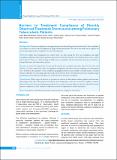Please use this identifier to cite or link to this item:
https://hdl.handle.net/20.500.14356/1137| Title: | Barriers to Treatment Compliance of Directly Observed Treatment Shortcourse among Pulmunary Tuberculosis Patients |
| Authors: | Marahatta, Sujan Babu Yadav, Rajesh Kumar Baral, Sushila Aryal, Neeta Paudel, Srijana Shah, Naveen Prakash Yadav, Punita Gurung, Suman Chandra Khatri, Elina |
| Citation: | MarahattaS. B., YadavR. K., BaralS., AryalN., PaudelS., ShahN. P., YadavP., GurungS. C., & KhatriE. (2021). Barriers to Treatment Compliance of Directly Observed Treatment Shortcourse among Pulmunary Tuberculosis Patients. Journal of Nepal Health Research Council, 19(03), 450-459. https://doi.org/10.33314/jnhrc.v19i3.3478 |
| Issue Date: | 2021 |
| Publisher: | Nepal Health Research Council |
| Article Type: | Original Article |
| Keywords: | Barriers DOTS mixed method Nepal treatment compliance tuberculosis |
| Series/Report no.: | July-Sep, 2021;3478 |
| Abstract: | Abstract Background: Treatment compliance is an important aspect for tuberculosis prevention and control. Poor compliance to treatment can lead to the development of drug-resistant tuberculosis. The aim of this study was to explore the factors affecting treatment compliance for tuberculosis patients. Methods: Facility based unmatched case control study was done among the forty non-compliance and eighty compliance pulmonary tuberculosis patients registered at selected directly observed treatment short-course centers of six districts. Data were collected using in-depth interview guideline with the tuberculosis focal person and Focus Group Discussion with tuberculosis patients. Results: A total of 120 respondents, 40 cases and 80 controls were enrolled in the study. About 72.5% of the cases and 56.2% of the controls were male. Five significant independent risk factors for non-compliance to TB treatment were identified. The qualitative session confirmed geographical barriers, inaccessibility to health facility, economic barriers, difficulty in convincing people, knowledge about Directly observed treatment shortcourse program, longer medication period, migration and stigma as a major barrier for treatment compliance. Conclusions: Wider ranges of barriers are prevalent in context of tuberculosis treatment pathway and outcome. Knowledge of the tuberculosis patients and attitude of the family plays a vital role in treatment compliance. Directly observed treatment shortcourse playing tremendous role to ensure treatment adherence has been identified as major barrier to adherence as well. Enablers of adherence need to be emphasized to address the barriers. Keywords: Barriers; DOTS; mixed method; Nepal; treatment compliance; tuberculosis |
| Description: | Original Article |
| URI: | http://103.69.126.140:8080/handle/20.500.14356/1137 |
| ISSN: | Print ISSN: 1727-5482; Online ISSN: 1999-6217 |
| Appears in Collections: | Vol. 19 No. 03 (2021): Vol 19 No 3 Issue 52 Jul-Sep 2021 |
Files in This Item:
| File | Description | Size | Format | |
|---|---|---|---|---|
| 3478-Manuscript-25058-1-10-20211215.pdf | Fulltext Download | 292.11 kB | Adobe PDF |  View/Open |
Items in DSpace are protected by copyright, with all rights reserved, unless otherwise indicated.
